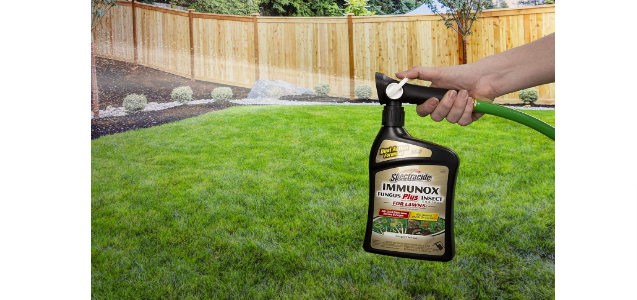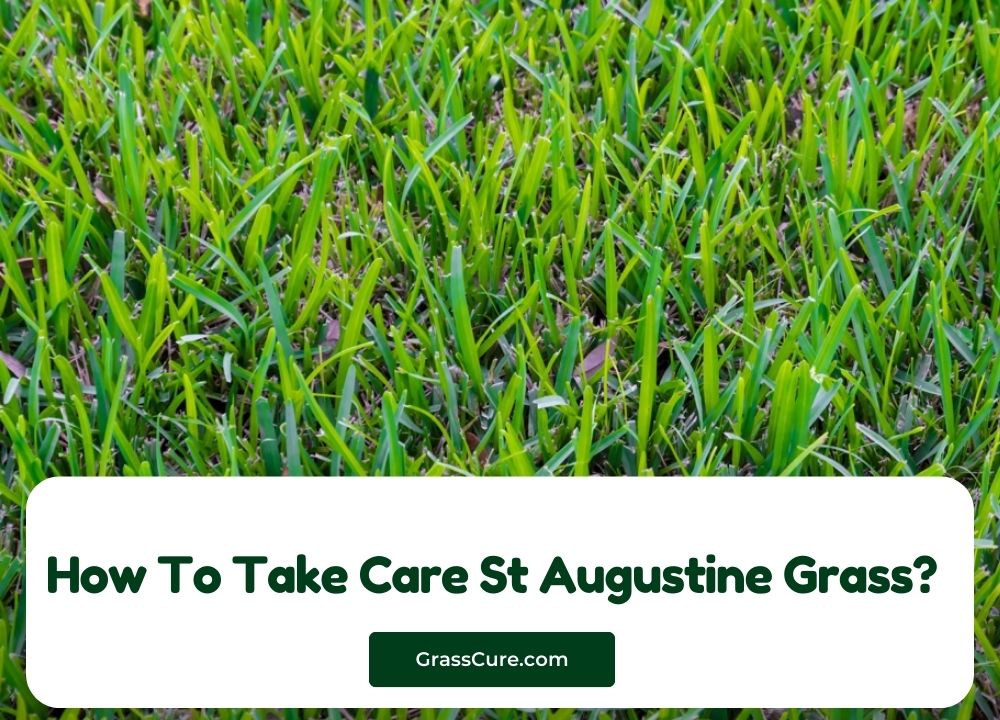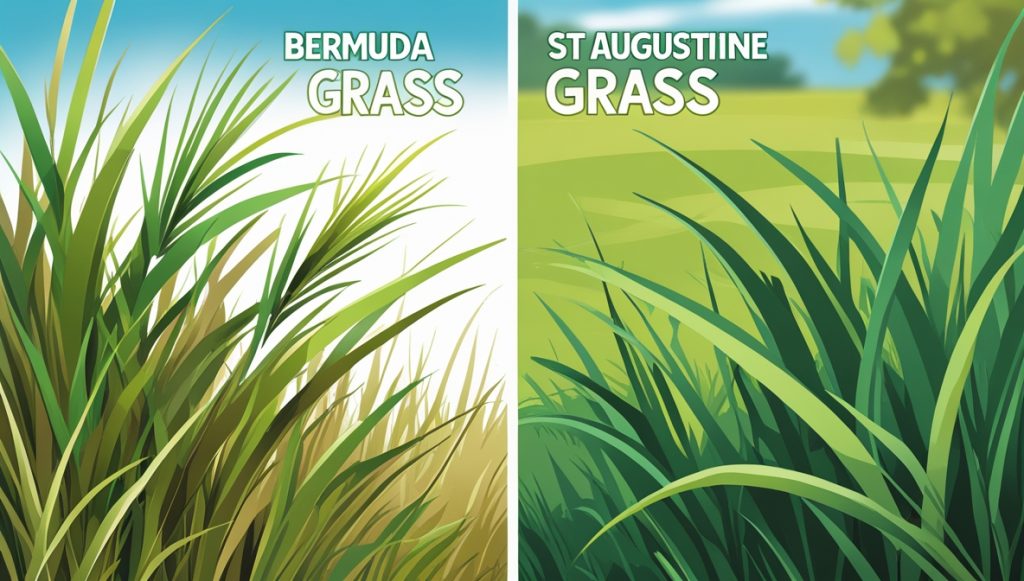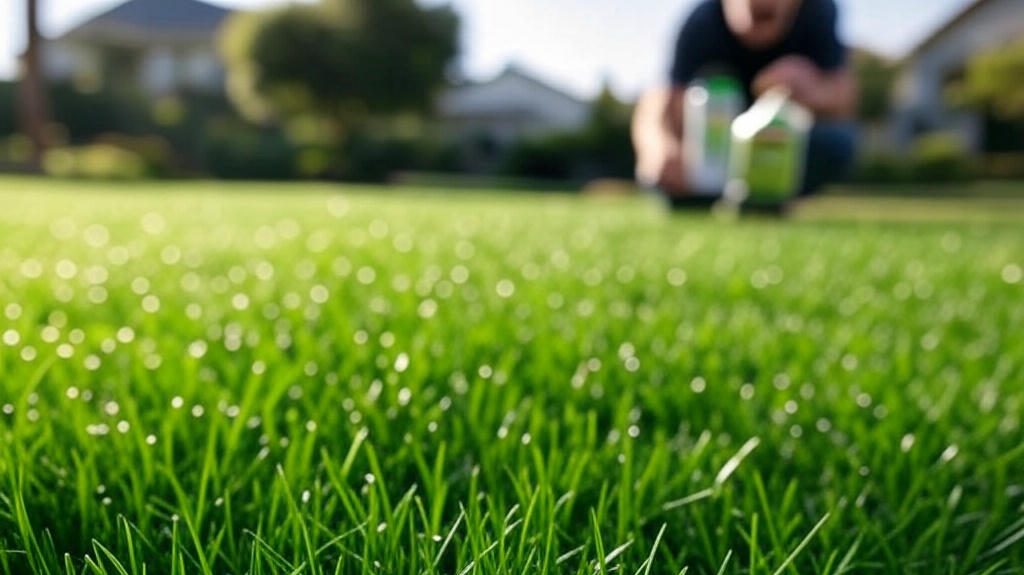St. Augustine grass is a favorite for lawns in warm, coastal climates thanks to its dense, green cover and hardy nature. But even this resilient grass can fall victim to fungal diseases, which can quickly turn your lush lawn into a patchy, discolored mess. To keep St. Augustine grass looking its best, it’s essential to understand how to prevent and treat these fungal issues. That’s where fungicides come in. In this guide, we’ll explore the best fungicide for St Augustine grass so you can enjoy a vibrant, healthy lawn all year long.
Contents
- Why Fungal Infections Affect St. Augustine Grass
- Quali-Pro 83013366 Propiconazole 14.4 Fungicide, 32oz, White
- Bonide Infuse Systemic Disease Control, 32 oz Ready-to-Spray Solution for Lawn & Landscape, Fungicide for Turf & Ornamentals
- Earth’s Ally Fungicide for Lawns | 32 fl. oz. Ready-to-Spray, Treats 5,000 Sq. Ft. | Natural Spray | Pet Safe | Bee Safe
- Jonathan Green (10236) Lawn Fungus Control – Fungicide for Lawns (15,000 Sq. Ft.)
- Spectracide Immunox Fungus Plus Insect, 1 Pack
- Factors to Consider When Choosing a Fungicide
- How to Apply Fungicide on St. Augustine Grass
- Prevention Tips to Reduce Fungal Growth in St. Augustine Grass
- Frequently Asked Questions
- Conclusion
- References
Why Fungal Infections Affect St. Augustine Grass
Fungal infections are a common issue for St. Augustine grass, mainly because of the grass’s preference for warm, humid climates, which are the ideal conditions for fungi to thrive. This grass type is especially susceptible to diseases like brown patch, gray leaf spot, and take-all root rot. Each of these fungal infections can be triggered by a combination of environmental conditions and improper lawn care practices, which can stress the grass and weaken its natural defenses.
St. Augustine grass is often grown in regions with high humidity, such as the southern United States, where frequent rain or high nighttime humidity keeps grass blades damp. Fungi flourish in these wet conditions, spreading through spores that can move easily through air, water, and even lawn equipment. When the grass stays wet for extended periods—such as after heavy rain, frequent watering, or dense morning dew—fungal spores find the perfect environment to invade the grass tissue.
Improper maintenance practices can also make St. Augustine grass more prone to infection. Overwatering, for instance, can leave the soil overly saturated, which not only promotes fungal growth but also weakens grass roots by limiting oxygen. Likewise, cutting the grass too short, using dull mower blades, or applying too much nitrogen fertilizer can stress the grass, making it more vulnerable to infections. Proper maintenance, such as using the right watering schedule and practicing good mowing habits, can help reduce the risk, but fungicides are sometimes necessary to stop or prevent these infections from spreading.
Quali-Pro 83013366 Propiconazole 14.4 Fungicide, 32oz, White

The Quali-Pro 83013366 Propiconazole 14.4 Fungicide is a popular choice for controlling various fungal diseases in lawns, including those that commonly affect St. Augustine grass. Here’s an overview of what makes this fungicide a good option and how it works:
Product Overview
- Name: Quali-Pro Propiconazole 14.4 Fungicide
- Active Ingredient: Propiconazole 14.3%
- Size: 32 oz
- Color: White (bottle)
This fungicide is a systemic treatment, meaning it absorbs into the plant tissue, providing protection from the inside out. It is effective against a broad range of fungal diseases like brown patch, dollar spot, leaf spot, and other common lawn diseases.
Key Features and Benefits
- Broad-Spectrum Control: Effective on a variety of fungal diseases that can target St. Augustine grass, such as brown patch and take-all root rot.
- Long-Lasting Protection: Systemic action helps protect the grass for weeks after application, meaning you don’t have to reapply frequently.
- Preventative and Curative Use: Can be used both to prevent fungal infections in susceptible areas and to treat active outbreaks.
- Easy Application: Can be mixed with water and applied using a tank sprayer for even coverage.
Application Tips for St. Augustine Grass
- When to Apply: Early morning when temperatures are cooler, or later in the evening. Avoid application in high heat to prevent stress on the grass.
- Frequency: For preventative use, apply every 14-21 days during high-risk times (warm, humid conditions). For curative use, follow specific label recommendations for more frequent application.
- Dilution and Coverage: Follow the manufacturer’s directions to dilute the fungicide properly. Over-application can harm grass, so measure carefully based on your lawn’s size.
Pros and Cons
- Pros: Effective on a range of fungi, long-lasting, and both preventative and curative.
- Cons: Requires careful measuring and application, slightly higher cost compared to some other fungicides, and should be applied with caution around pets and kids until it dries.
Safety Considerations
- Be sure to wear gloves, protective eyewear, and avoid contact with skin when mixing and applying this fungicide.
- Keep pets and children off the treated area until it has dried completely.
The Quali-Pro Propiconazole fungicide is a solid choice for homeowners looking to protect or restore their St. Augustine grass from fungal diseases, ensuring the lawn stays vibrant and healthy.
Bonide Infuse Systemic Disease Control, 32 oz Ready-to-Spray Solution for Lawn & Landscape, Fungicide for Turf & Ornamentals
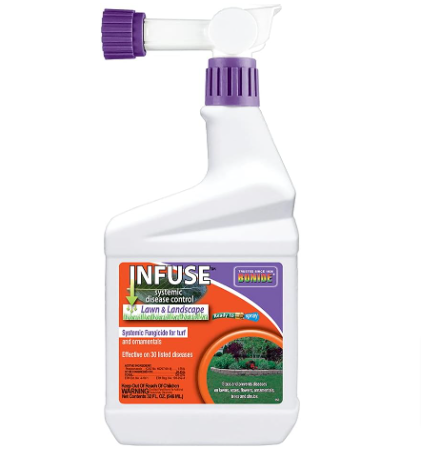
Bonide Infuse Systemic Disease Control is a versatile fungicide designed to protect lawns and ornamental plants from various fungal infections. This ready-to-spray solution is a convenient and effective option, especially for homeowners managing fungal issues in turfgrass like St. Augustine. Here’s an overview of how it works, its main benefits, and application tips for optimal results.
Product Overview
- Name: Bonide Infuse Systemic Disease Control
- Size: 32 oz, Ready-to-Spray
- Application: Lawn and Landscape
Bonide Infuse is a systemic fungicide, meaning it penetrates and moves within the grass, providing extended protection from inside the plant tissue. It targets several common fungal diseases affecting St. Augustine grass, including brown patch, rust, and powdery mildew. The “ready-to-spray” feature allows for quick, convenient application with no need for mixing, making it ideal for homeowners.
Key Features and Benefits
- Broad-Spectrum Disease Control: Effective against a variety of fungi that can damage both turf and ornamentals, such as leaf spots, blights, and root rots.
- Systemic Protection: Works from the inside, helping prevent new fungal growth and suppressing active infections.
- Extended Coverage: Provides protection for up to four weeks after application, reducing the need for frequent treatments.
- Ready-to-Use Convenience: The attached hose-end sprayer simplifies application—just connect to a garden hose and spray directly.
Application Tips for St. Augustine Grass
- When to Apply: Ideal for early morning or late evening when temperatures are cooler, and grass is not under direct sunlight.
- Application Frequency: For prevention, apply every 3-4 weeks during the growing season, especially in humid, wet conditions that promote fungal growth. For active infections, apply every two weeks until the problem subsides.
- How to Use: Attach the bottle to a garden hose, turn on the water, and apply an even layer across the lawn. Walk at a steady pace to ensure thorough, even coverage over all grass.
Pros and Cons
- Pros:
- Simple application process with no mixing required.
- Effective on both lawns and ornamentals, making it versatile for landscaping needs.
- Long-lasting protection, reducing the need for reapplication.
- Cons:
- Limited control over application rate, so careful coverage is needed.
- Not pet- or child-safe until fully dry, requiring some caution post-application.
Safety Considerations
- Avoid spraying on windy days to prevent drift, which can lead to unintentional contact with surrounding plants or people.
- Wear gloves and eye protection during application, and keep pets and children away from the treated area until it’s completely dry.
Bonide Infuse Systemic Disease Control offers an effective, easy-to-use solution for protecting St. Augustine grass and other plants from fungal diseases, helping maintain a lush and healthy lawn with minimal effort.
Earth’s Ally Fungicide for Lawns | 32 fl. oz. Ready-to-Spray, Treats 5,000 Sq. Ft. | Natural Spray | Pet Safe | Bee Safe
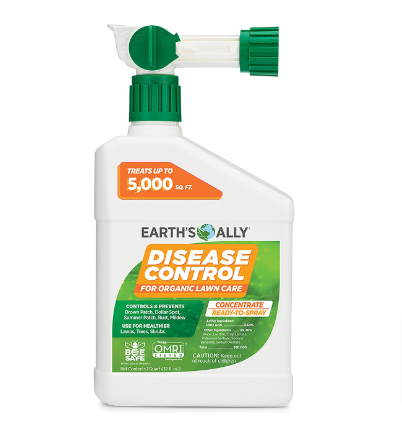
Earth’s Ally Fungicide for Lawns is a natural, environmentally friendly fungicide designed for lawn care, particularly for homeowners who prioritize safe, non-toxic products. This ready-to-spray fungicide targets common fungal diseases in lawns, including those affecting St. Augustine grass, while being safe for pets, children, and beneficial insects like bees.
Product Overview
- Name: Earth’s Ally Fungicide for Lawns
- Size: 32 fl. oz., Ready-to-Spray
- Coverage: Treats up to 5,000 sq. ft.
- Safety: Pet-safe and bee-safe
This fungicide uses a natural formula that’s effective against several common fungal issues, such as powdery mildew, black spot, and rust, without relying on harsh chemicals. Its ready-to-spray bottle allows for easy, even application across the lawn and garden, making it a convenient choice for eco-conscious homeowners.
Key Features and Benefits
- Natural, Eco-Friendly Ingredients: Free from synthetic chemicals, which makes it safe for use around pets, children, and pollinators like bees.
- Broad-Spectrum Disease Control: Effective against common lawn fungi that can damage St. Augustine grass, such as leaf spots and rust.
- Ready-to-Spray Convenience: Simply attach to a garden hose and apply directly, with no need for mixing.
- Generous Coverage: The 32 oz bottle treats up to 5,000 sq. ft., making it suitable for medium to large lawns.
Application Tips for St. Augustine Grass
- When to Apply: Apply in the early morning or evening when temperatures are cooler, avoiding hot, sunny periods to prevent grass stress.
- Application Frequency: For prevention, apply every 2-3 weeks during peak growing season or humid weather, which is ideal for fungal growth. For treatment of existing infections, apply every 7-10 days until symptoms decrease.
- How to Use: Attach the bottle to a garden hose, turn on the water, and spray evenly across the entire lawn. For best results, maintain a steady walking pace to ensure even application across all areas.
Pros and Cons
- Pros:
- Safe for pets, children, and pollinators, making it a family-friendly option.
- No synthetic chemicals, which reduces environmental impact.
- Convenient, ready-to-spray format eliminates the need for mixing.
- Cons:
- Natural formulas may take longer to show visible results compared to chemical fungicides.
- Requires frequent application for ongoing protection, especially in heavily infected areas.
Safety Considerations
- This fungicide is safe to use around people, pets, and pollinators right after application. However, it’s still a good idea to allow the lawn to dry completely before allowing kids or pets to play on it.
- While the natural formula is gentle, avoid spraying during peak bee foraging times (typically midday) to ensure it doesn’t disturb beneficial insects.
Earth’s Ally Fungicide for Lawns is an excellent option for those seeking a natural solution to manage fungal infections in St. Augustine grass while maintaining a safe environment for their family and local wildlife. It combines effective fungal control with eco-conscious ingredients, making it a versatile choice for healthy, sustainable lawn care.
Jonathan Green (10236) Lawn Fungus Control – Fungicide for Lawns (15,000 Sq. Ft.)

Jonathan Green Lawn Fungus Control is a highly effective fungicide that provides extensive coverage, designed for large lawn areas up to 15,000 square feet. Ideal for homeowners looking to control fungal infections in expansive St. Augustine grass lawns, this granular fungicide offers both preventative and curative treatment options.
Product Overview
- Name: Jonathan Green Lawn Fungus Control
- Size: 15,000 sq. ft. coverage, granular form
- Application: Lawn-specific fungicide
This fungicide is effective against a wide range of fungal diseases that affect St. Augustine grass, including brown patch, dollar spot, and summer patch. Its granular formulation makes it easy to apply evenly across large areas, providing lasting protection without needing frequent reapplication.
Key Features and Benefits
- Large Coverage Area: Designed to treat up to 15,000 sq. ft., making it cost-effective for big lawns.
- Broad-Spectrum Fungal Control: Controls common fungal infections like brown patch, fusarium blight, and rust, which are particularly troublesome for St. Augustine grass.
- Dual Action: Works as both a preventative and curative fungicide, making it versatile for early intervention or treating active outbreaks.
- Long-Lasting Protection: With systemic absorption, it continues to protect the grass from fungal threats for several weeks after application.
Application Tips for St. Augustine Grass
- When to Apply: Apply during periods of high humidity and rainfall or when fungal disease symptoms first appear. Early morning or evening applications are ideal for minimizing heat stress.
- Application Frequency: For preventative care, apply every 3-4 weeks during the growing season. For active infections, follow label instructions for reapplication to effectively curb the disease.
- How to Use: Spread the granules evenly across the lawn using a broadcast or drop spreader, following label recommendations for specific spreader settings. Water the lawn lightly after application to help the fungicide penetrate the soil.
Pros and Cons
- Pros:
- Covers a large area, making it suitable and economical for big lawns.
- Provides both preventative and treatment benefits.
- Granular form allows easy and even application without mixing.
- Cons:
- Requires a spreader, which may be an additional purchase for some.
- Not pet- or child-safe until it is thoroughly watered into the soil and allowed to dry.
Safety Considerations
- Keep children and pets off the treated lawn until it has been watered and the product has dried.
- Wear gloves when handling and applying granules to minimize skin contact.
Jonathan Green Lawn Fungus Control is an excellent choice for treating large lawns and is effective against the most common fungal diseases affecting St. Augustine grass. With its broad-spectrum coverage and dual preventative and curative action, this fungicide can help maintain a healthy, green lawn all season long.
Spectracide Immunox Fungus Plus Insect, 1 Pack
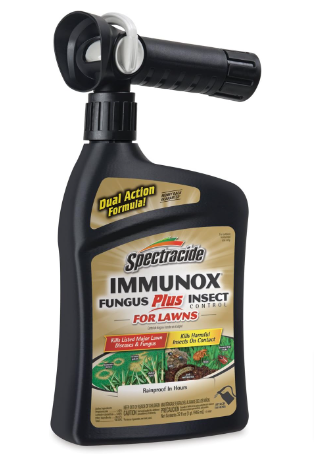
Spectracide Immunox Fungus Plus Insect is a dual-action treatment designed to control both fungal diseases and insect pests in lawns. This combination product is convenient for homeowners seeking to tackle multiple lawn issues—such as fungal infections and common pests—without needing separate applications.
Product Overview
Name: Spectracide Immunox Fungus Plus Insect
Pack Size: 1 Pack
Application: Dual-purpose fungicide and insecticide for lawns
This formula is particularly effective for St. Augustine grass, providing broad-spectrum fungal control for diseases like brown patch, black spot, and dollar spot while also targeting insects like chinch bugs, sod webworms, and ants. Its versatile application saves time and effort, making it an ideal choice for lawns needing both fungal and insect control.
Key Features and Benefits
- Dual Fungus and Insect Control: Combines a fungicide and insecticide, eliminating the need for multiple treatments.
- Broad-Spectrum Protection: Effective against common fungal diseases and pests that impact St. Augustine grass, offering well-rounded lawn care.
- Weather-Resistant Formula: The treatment is rainproof, making it durable even in humid or rainy weather. Protection remains effective for up to two weeks.
- Convenient Application: Ready-to-spray formulation that attaches to a garden hose, making it easy to apply evenly over the entire lawn.
Application Tips for St. Augustine Grass
- When to Apply: For optimal results, apply early in the morning or late in the afternoon when temperatures are cooler, and grass is less stressed.
- Application Frequency: Apply every two weeks during active fungal or insect infestations. For prevention, apply once every month or as needed to maintain coverage.
- How to Use: Attach the bottle to a garden hose, turn on the water, and spray across the lawn. Walk at a steady pace to ensure even coverage, focusing on areas showing symptoms of fungal infection or insect damage.
Pros and Cons
- Pros:
- Combines fungicide and insecticide in one product, saving time and effort.
- Effective on a wide range of fungi and insects, making it a versatile solution.
- Ready-to-spray bottle allows easy application.
- Cons:
- Frequent reapplication may be needed during heavy infestations.
- Not pet- or child-safe until the treated lawn is fully dry, requiring caution.
Safety Considerations
- Wear gloves and eye protection when applying the product.
- Keep pets and children off the lawn until the solution has dried completely, which can take a few hours depending on weather conditions.
Spectracide Immunox Fungus Plus Insect is an excellent choice for St. Augustine grass when dealing with both fungal and insect threats. Its dual-action formula offers comprehensive lawn care, simplifying treatment routines and providing long-lasting protection against common problems that can affect lawn health.
Factors to Consider When Choosing a Fungicide
When it comes to selecting the right fungicide for your lawn, especially for specific grass types like St. Augustine, there are several key factors to keep in mind. Understanding these aspects can help you make an informed choice, ensuring effective disease management while also protecting the health of your lawn and the surrounding environment. Here’s a breakdown of the important factors to consider:
1. Type of Fungus
Different fungicides target specific types of fungi. Before choosing a product, identify the fungal disease affecting your lawn. Common St. Augustine grass diseases include:
- Brown Patch: Caused by the Rhizoctonia fungus, this is one of the most prevalent issues for St. Augustine grass.
- Gray Leaf Spot: Affects the grass’s leaves and causes circular, grayish spots.
- Take-All Root Rot: This fungus attacks the roots, leading to thinning and browning of the grass.
Once you know the specific fungus, you can select a fungicide that is effective against that particular disease.
2. Preventative vs. Curative Options
Fungicides fall into two main categories: preventative and curative.
- Preventative Fungicides: These are applied before any signs of disease appear, helping to inhibit fungal growth and protect the grass from infection. They are often used during high-risk periods, such as during humid, wet weather.
- Curative Fungicides: These are designed to treat active infections. If your lawn is already showing signs of disease, a curative fungicide may be necessary.
Choosing the right type based on your lawn’s needs will impact both effectiveness and the overall health of your grass.
3. Application Method
Fungicides come in various forms, including:
- Granular: These are typically spread over the lawn using a broadcast or drop spreader. They often provide longer-lasting effects and are less prone to wash away with rain.
- Liquid: These fungicides are usually mixed with water and applied with a sprayer. They can penetrate quickly and may offer faster results but might require more frequent applications.
Consider which method you prefer and what best suits your lawn size and layout.
4. Environmental Impact
Many homeowners are becoming more environmentally conscious, so it’s essential to choose fungicides that are safe for pets, children, and beneficial wildlife, such as bees. Look for products labeled as organic or natural, which often have fewer harmful chemicals. Additionally, consider the potential impact on surrounding plants and soil health, opting for products that minimize damage to beneficial organisms.
5. Product Concentration and Coverage Area
Different fungicides have varying concentrations of active ingredients, which can affect their potency and the area they cover. Be sure to:
- Read the Label: Understand how much product you need based on the size of your lawn and the recommended application rates.
- Calculate Coverage: Some products might seem more economical due to their larger sizes, but if they require higher application rates, they may not be as cost-effective.
6. Timing and Seasonal Considerations
The timing of your application is crucial for both preventative and curative fungicides. Some products are more effective during specific seasons or weather conditions. For instance:
- Warm, Humid Conditions: These are prime times for fungal growth, making it essential to apply fungicides preemptively.
- Cooler Weather: Some fungicides may not perform as well in cooler conditions, so timing your application to coincide with peak fungal activity is key.
7. Resistance Management
Overuse of a single fungicide can lead to resistance in fungal populations. To combat this, consider rotating different fungicide classes or formulations to reduce the chance of resistance development. This not only helps in managing the current fungal issue but also safeguards against future outbreaks.
8. Cost and Availability
Lastly, consider your budget and the availability of the fungicide in your area. While some high-end products may offer excellent performance, there are often effective alternatives at lower price points. Compare different options, read reviews, and consider local availability when making your selection.
How to Apply Fungicide on St. Augustine Grass
Applying fungicide to St. Augustine grass is a critical step in managing and preventing fungal diseases that can harm this popular lawn type. Proper application techniques ensure effective disease control while minimizing risks to the grass and the environment. Here’s a detailed guide on how to apply fungicide on St. Augustine grass effectively.
1. Choose the Right Fungicide
Before you start, select a fungicide that is specifically effective against the fungal diseases affecting St. Augustine grass. Familiarize yourself with the active ingredients and their target diseases, as well as whether the product is for preventive or curative use.
2. Read the Label Instructions
Always read the manufacturer’s label thoroughly before use. The label contains essential information about:
- Target Diseases: What the product is effective against.
- Application Rate: How much fungicide to use per area.
- Frequency of Application: How often to apply the product.
- Safety Precautions: Any protective gear required and waiting times for pets or children.
3. Prepare Your Lawn
To ensure effective fungicide application, follow these preparatory steps:
- Mow the Grass: Mow your St. Augustine grass to the recommended height, usually around 2.5 to 4 inches. This allows the fungicide to reach the turf more effectively.
- Water Your Lawn: Water the grass a day or two before applying fungicide. This helps to ensure the soil is moist but not soggy. A well-hydrated lawn allows the fungicide to penetrate better and reduces stress on the grass.
- Clear Debris: Remove any leaves, branches, or debris from the lawn. This ensures even coverage and prevents barriers that may impede the fungicide’s effectiveness.
4. Gather Necessary Equipment
Depending on the type of fungicide you’re using, you may need different equipment:
- For Liquid Fungicides: A sprayer, such as a backpack sprayer, hand-held sprayer, or hose-end sprayer.
- For Granular Fungicides: A broadcast spreader or drop spreader for even distribution.
5. Measure and Mix the Fungicide
For liquid fungicides:
- Dilution: Follow the label’s directions for the correct dilution ratio. Use clean water to mix the fungicide in the sprayer.
- Stir Well: If it requires mixing, ensure the product is well mixed before application.
For granular fungicides:
- Measure: Use the recommended amount of granules based on the area you plan to treat.
6. Apply the Fungicide
Liquid Fungicides:
- Even Coverage: Start at one corner of your lawn and spray evenly across the entire area. Overlap each pass slightly to ensure no spots are missed.
- Walking Pace: Move at a steady pace to avoid over-saturating any one area.
- Focus on Affected Areas: If treating an active infection, concentrate on areas showing signs of disease while still applying evenly across the entire lawn.
Granular Fungicides:
- Set the Spreader: Adjust your spreader settings according to the label recommendations.
- Application Pattern: Walk in a straight line while evenly distributing the granules. Make overlapping passes to ensure uniform coverage, avoiding clumps.
- Watering After Application: After applying the granules, lightly water the lawn to help the product penetrate the soil and activate its efficacy.
7. Follow Up
After applying the fungicide, it’s essential to monitor your lawn:
- Observe Grass Health: Look for improvements in affected areas, such as reduced discoloration or regrowth.
- Reapply as Needed: Based on the product’s instructions, follow up with additional applications as required, especially if you’re dealing with an active infection.
8. Practice Safety Measures
- Protective Gear: Wear gloves, long sleeves, and a mask if recommended, especially when mixing or applying fungicides.
- Keep Pets and Children Away: Ensure pets and children stay off the treated lawn until it has dried completely, which can take several hours.
9. Consider Environmental Factors
- Weather Conditions: Avoid applying fungicide during windy days to prevent drift, and refrain from spraying before heavy rainfall.
- Optimal Temperatures: Aim for applications when temperatures are moderate, avoiding extreme heat or cold.
Prevention Tips to Reduce Fungal Growth in St. Augustine Grass
Preventing fungal growth in St. Augustine grass is crucial for maintaining a healthy, lush lawn. Fungal diseases can be detrimental, leading to unsightly patches and weakened turf. Here are some effective prevention tips to help you keep your St. Augustine grass healthy and resistant to fungal infections.
1. Choose the Right Variety
When selecting St. Augustine grass, consider choosing disease-resistant varieties. Some cultivars are more resilient to fungal infections, such as:
- Floratam: Known for its drought resistance and resilience to brown patch.
- Palmetto: A shade-tolerant variety with good resistance to various diseases.
Research and select a variety suitable for your local climate and soil conditions to minimize the risk of disease.
2. Proper Mowing Practices
Mowing plays a significant role in lawn health and disease prevention:
- Mow at the Correct Height: St. Augustine grass thrives at a height of 2.5 to 4 inches. Keeping it at this height promotes deep root growth and reduces stress on the grass.
- Mow with Sharp Blades: Dull mower blades can tear the grass, creating openings for fungi to enter. Regularly sharpen your mower blades to ensure a clean cut.
- Avoid Cutting Wet Grass: Mowing when the grass is wet can lead to uneven cuts and promote fungal growth. Aim to mow when the grass is dry.
3. Optimize Watering Practices
Watering is essential for lawn health, but overwatering can lead to fungal growth:
- Water Deeply and Infrequently: Instead of frequent shallow watering, aim to water deeply (about 1 inch per week). This encourages deep root growth and reduces the chances of surface diseases.
- Water Early in the Day: Watering in the morning allows grass blades to dry out during the day, reducing the time they remain damp and susceptible to fungal growth.
- Use a Rain Gauge: Monitor rainfall and adjust your watering schedule accordingly to prevent overwatering.
4. Improve Air Circulation
Good air circulation is vital in preventing fungal diseases:
- Aerate Your Lawn: Aerating your lawn once a year can relieve compaction and improve airflow to the roots. This can be especially beneficial in heavy clay soils.
- Trim Surrounding Vegetation: Ensure trees and shrubs are not overcrowding the lawn, as they can block sunlight and air circulation, creating a humid environment conducive to fungal growth.
5. Fertilize Wisely
Proper fertilization can promote healthy grass, making it more resistant to diseases:
- Use the Right Fertilizer: Choose a slow-release nitrogen fertilizer that is appropriate for St. Augustine grass. Over-fertilizing can lead to excessive growth, making the grass more prone to fungal infections.
- Follow a Fertilization Schedule: Apply fertilizer according to the season and growth cycles. Typically, fertilizing in late spring and early fall is beneficial for St. Augustine grass.
6. Maintain Soil Health
Healthy soil supports robust grass growth and reduces the likelihood of disease:
- Test Your Soil: Conduct a soil test to determine nutrient levels and pH. Amend your soil based on the test results to ensure optimal growing conditions for St. Augustine grass.
- Add Organic Matter: Incorporate compost or well-rotted manure into the soil to improve its structure and nutrient content.
7. Practice Good Lawn Hygiene
Keeping your lawn clean can help prevent the spread of diseases:
- Remove Debris: Regularly rake up leaves, dead grass, and other debris from your lawn. These materials can harbor fungal spores.
- Keep Tools Clean: Clean your lawn care tools regularly to prevent the transfer of pathogens from one area to another.
8. Monitor for Signs of Disease
Early detection can help manage fungal issues before they spread:
- Regular Inspections: Regularly check your lawn for signs of fungal infections, such as discolored patches, unusual spots, or wilting.
- Act Quickly: If you notice any signs of disease, take immediate action by addressing environmental factors or applying fungicides as needed.
9. Adjust Cultural Practices for Seasonal Changes
Different seasons present unique challenges for St. Augustine grass:
- Spring Preparation: As the weather warms, ensure your lawn is properly aerated and fertilized to promote healthy growth.
- Summer Care: Be vigilant about watering and mowing practices during the heat, as stress can increase vulnerability to fungal diseases.
- Fall Maintenance: Prepare your lawn for cooler temperatures by adjusting your watering and mowing habits, as well as applying a late-season fertilizer.
10. Limit Pesticide Use
While fungicides can be effective, reliance on them should be minimized:
- Use Pesticides Judiciously: Overusing fungicides can lead to resistance. Employ them only when necessary and follow label instructions carefully.
- Integrate Integrated Pest Management (IPM): Consider implementing IPM practices that emphasize prevention and monitoring before resorting to chemical treatments.
Frequently Asked Questions
When it comes to maintaining St. Augustine grass and managing fungal diseases, homeowners often have several common questions. Here are some frequently asked questions (FAQs) along with their answers to help you better understand the care and treatment of your lawn.
1. What are the common fungal diseases that affect St. Augustine grass?
St. Augustine grass is susceptible to various fungal diseases, including:
- Brown Patch: Causes circular brown patches in the lawn, especially during warm, humid weather.
- Gray Leaf Spot: Appears as circular, grayish spots on the leaves, often affecting older grass.
- Take-All Root Rot: Affects the roots, leading to thinning and browning of the grass, often seen in the spring and fall.
2. How can I tell if my St. Augustine grass has a fungal infection?
Signs of fungal infections in St. Augustine grass include:
- Discolored patches (brown, gray, or yellow spots)
- Wilting or dying grass
- Unusual leaf spots or lesions
- Areas of grass that appear thin or bare Monitoring your lawn regularly for these symptoms can help with early detection.
3. How often should I apply fungicide to my lawn?
The frequency of fungicide application depends on the product and the specific needs of your lawn. Generally:
- Preventative Applications: Every 3-4 weeks during high-risk periods (e.g., warm, humid weather).
- Curative Applications: Follow label instructions, often requiring reapplication every 2-3 weeks until the disease is controlled.
Always refer to the manufacturer’s label for specific recommendations for your chosen fungicide.
4. Can I prevent fungal infections without using fungicides?
Yes, many cultural practices can help prevent fungal infections, including:
- Maintaining proper mowing height (2.5 to 4 inches)
- Watering deeply but infrequently, preferably in the morning
- Improving air circulation through aeration and trimming surrounding plants
- Choosing disease-resistant grass varieties
- Implementing good lawn hygiene by removing debris
5. What is the best time to apply fungicide?
The best time to apply fungicide is during the early morning or late afternoon when temperatures are cooler and grass is less stressed. Avoid applying during extremely hot, dry conditions or when rain is expected soon after application.
6. How do I improve the overall health of my St. Augustine grass?
To enhance the health of your St. Augustine grass:
- Ensure adequate watering (about 1 inch per week).
- Fertilize with a slow-release nitrogen fertilizer during the growing season.
- Aerate the lawn annually to relieve compaction.
- Monitor for pests and diseases, addressing issues promptly.
7. Are there natural or organic fungicides I can use?
Yes, several natural fungicides can help manage fungal infections, including:
- Neem Oil: Effective against various fungal diseases.
- Baking Soda: Can help control powdery mildew when mixed with water and applied as a spray.
- Milk Spray: Some studies suggest diluted milk can help prevent fungal diseases.
Always test a small area before applying any new treatment to ensure it does not harm your grass.
8. How can I promote better drainage to prevent fungal growth?
Improving drainage in your lawn can help reduce fungal growth. Consider:
- Aerating the soil to relieve compaction.
- Adding organic matter to improve soil structure.
- Creating contouring or slight slopes to encourage water runoff.
9. What should I do if my St. Augustine grass is already infected?
If your St. Augustine grass shows signs of infection:
- Identify the specific disease affecting your lawn.
- Apply an appropriate fungicide following label instructions for application and frequency.
- Adjust your cultural practices (e.g., watering, mowing) to reduce stress on the grass.
- Monitor the affected areas for improvement and reapply as needed.
10. Can I overseed my St. Augustine grass, and how does it affect fungal growth?
Overseeding St. Augustine grass can be beneficial for improving lawn density, but it should be done carefully. Choose a compatible seed type, and consider timing (usually during cooler seasons). Healthy, dense grass can be more resistant to fungal diseases, but be sure to follow proper cultural practices to minimize risks.
Conclusion
Maintaining a vibrant and healthy St. Augustine lawn requires a proactive approach, particularly when it comes to preventing and managing fungal diseases. By understanding the common issues that can affect your grass, employing effective cultural practices, and using fungicides responsibly, you can create a lush, disease-resistant landscape that enhances your outdoor space.
In this guide, we’ve explored various aspects of fungal disease management, from identifying specific infections and applying fungicides to prevention strategies and lawn care techniques. Key practices, such as proper mowing, watering, and soil health maintenance, contribute significantly to the resilience of your St. Augustine grass.
By choosing disease-resistant grass varieties, practicing good lawn hygiene, and monitoring your lawn regularly, you can stay one step ahead of potential fungal threats. And while fungicides can be effective tools in your arsenal, remember that prevention is always better than cure. Focusing on cultural practices will help build a robust lawn environment that can withstand the pressures of disease.
Ultimately, the goal is to create a thriving outdoor space that not only looks great but also supports the health of your lawn and the surrounding ecosystem. With consistent attention and care, you can enjoy the beauty of your St. Augustine grass while minimizing the impact of fungal diseases. Happy lawn care!
References
- University of Florida IFAS Extension
- “St. Augustinegrass.” University of Florida. Link
This resource offers extensive information on St. Augustine grass, including its characteristics, cultural practices, and common pest and disease issues.
- “St. Augustinegrass.” University of Florida. Link
- North Carolina State University
- “Fungicides for Lawns.” North Carolina State University. Link
This guide discusses different fungicides available for lawn care, including their application and effectiveness.
- “Fungicides for Lawns.” North Carolina State University. Link
- University of California Agriculture and Natural Resources
- “Managing Diseases of Lawns.” Link
This publication provides an overview of common lawn diseases and management strategies, including fungicides and cultural practices.
- “Managing Diseases of Lawns.” Link
- The Lawn Institute
- “Understanding Fungal Diseases in Lawns.” Link
This resource explains the causes and treatments for fungal diseases that affect lawns, with a focus on prevention strategies.
- “Understanding Fungal Diseases in Lawns.” Link
- Mississippi State University Extension
- “Fungal Diseases of Lawns.” Link
This guide details the symptoms, causes, and management of various fungal diseases in lawns, including those affecting St. Augustine grass.
- “Fungal Diseases of Lawns.” Link
- Texas A&M AgriLife Extension
- “St. Augustinegrass Management.” Link
This resource outlines best practices for managing St. Augustine grass, including cultural practices and disease management.
- “St. Augustinegrass Management.” Link
- Purdue University Extension
- “Turfgrass Disease Management.” Link
This publication provides insights into disease management strategies for turfgrass, including identification and treatment of common lawn diseases.
- “Turfgrass Disease Management.” Link
- American Lawns
- “Caring for St. Augustine Grass.” Link
This site offers practical tips and techniques for maintaining a healthy St. Augustine lawn, including watering, mowing, and pest management.
- “Caring for St. Augustine Grass.” Link
